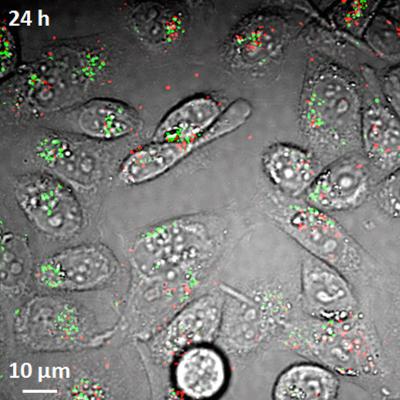A research team at Purdue University has developed a label-free imaging technique, dubbed as transient absorption, for monitoring nanostructures such as carbon nanotubes in the bloodstream and live cells, paving the way for advancing the applications of nanostructures in clinical medicine and biomedical research.
 Researchers have demonstrated a new imaging tool for tracking structures called single-wall carbon nanotubes in living cells and the bloodstream, work that could aid efforts to perfect their use in laboratory or medical applications. Here, the imaging system detects both metallic and semiconducting nanotubes, false-colored in red and green, in live hamster cells. (Weldon School of Biomedical Engineering, Purdue University)
Researchers have demonstrated a new imaging tool for tracking structures called single-wall carbon nanotubes in living cells and the bloodstream, work that could aid efforts to perfect their use in laboratory or medical applications. Here, the imaging system detects both metallic and semiconducting nanotubes, false-colored in red and green, in live hamster cells. (Weldon School of Biomedical Engineering, Purdue University)
The transient absorption imaging tool utilizes a pulsing near-infrared laser to dump energy into the nanotubes that are then investigated by using a second near-infrared laser. Purdue University’s Ji-Xin Cheng stated that the imaging tool is capable of tracking the activities of carbon nanotubes in the bloodstream in real time thanks to its ultra speed. As it is label free, the imaging tool eliminates the necessity to mark the nanotubes with dyes, enabling it to be suitable for medicine and research, Cheng said.
The novel imaging tool can detect both semiconducting and metallic nanotubes. However, the major issue in studying live cells using the transient absorption imaging tool was the intervention due to the brightness of red blood cells’ background, which is better than that of nanotubes.
To overcome this issue, the research team separated the signals from the nanotubes and red blood cells in two isolated ‘channels’ through ‘phase separation’ by delaying the light emitted from the red blood cells when compared to the light released from the nanotubes. The team utilized this tool to view the transportation of nanotubes in the blood vessels in the earlobes of the mice.
Carbon nanotubes are hydrophobic in nature. Thus, certain nanotubes were made water-soluble by coating them with DNA to facilitate their circulation inside cells and in the bloodstream. Cheng stated that for effective drug delivery, it is significant to view the transportation of nanotubes in the bloodstream in real time to get the data of the duration of their presence in blood vessels after their delivery.
The research team took pictures of the nanotube’s presence in the liver and other body parts to examine their circulation in mice. The team is also utilizing the imaging tool to analyze other nanomaterials including graphene.